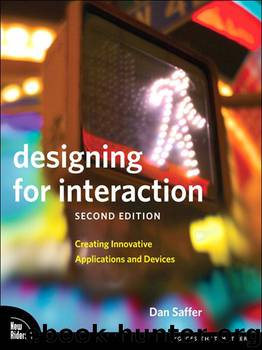Designing for Interaction: Creating Innovative Applications and Devices (Voices That Matter) by Dan Saffer

Author:Dan Saffer [Saffer, Dan]
Language: eng
Format: mobi
Publisher: Pearson Education
Published: 2009-09-25T04:00:00+00:00
Robert Reimann is an associate creative director at frog design and was the first president of the Interaction Design Association. He helped write the book on interaction design—literally, with Alan Cooper and David Cronin: About Face 3: The Essentials of Interaction Design.
How did the idea of personas come about?
The idea of personas, or tools like them, has been around for a long time. Many design, marketing, and usability professionals in the ’80s and ’90s made use of “user profiles” to help them visualize who their customers were, and to help them imagine what kind of needs and desires they might have in relation to products and services.
Alan Cooper, who coined the term “persona” for this type of tool, first did so in 1983, while designing and developing a software package called SuperProject for Computer Associates, and later did so for what eventually became Microsoft’s Visual Basic.
Cooper’s early personas were primitive, in that they were based on loose, personal observations of a small number of individuals in particular roles. However, Cooper’s fundamental insight was that these representative characters had goals and behaviors that could be served by products. By enumerating the most critical goals and including them as part of the persona description, Cooper developed a powerful design method: meet the persona’s top goals with the product by designing for their behaviors, and the design is much more likely to be successful.
My own contribution to Cooper’s persona methodology was to introduce more formal ethnographic field research as the data-gathering method for the information used to construct personas, and to (with Kim Goodwin) refine the persona goals into three types: experience goals, which describe how users wish to feel (or not to feel) when using a product; end goals, which describe what users actually want or need to accomplish with a product to meet their expectations; and life goals, which describe the broader aspirations of the persona in relation to the product, and thus help describe what the product means to the persona. It’s this focus on goals and behavior patterns, combined with a scenario-based method of translating these requirements into design solutions, that makes Cooper’s personas so unique and powerful.
Download
This site does not store any files on its server. We only index and link to content provided by other sites. Please contact the content providers to delete copyright contents if any and email us, we'll remove relevant links or contents immediately.
Hello! Python by Anthony Briggs(10121)
The Mikado Method by Ola Ellnestam Daniel Brolund(10013)
Dependency Injection in .NET by Mark Seemann(9518)
Sass and Compass in Action by Wynn Netherland Nathan Weizenbaum Chris Eppstein Brandon Mathis(7915)
Svelte with Test-Driven Development by Daniel Irvine(7816)
The Well-Grounded Java Developer by Benjamin J. Evans Martijn Verburg(7770)
Test-Driven Development with PHP 8 by Rainier Sarabia(7553)
Layered Design for Ruby on Rails Applications by Dementyev Vladimir;(7385)
Web Development with Django by Ben Shaw Saurabh Badhwar(6886)
Secrets of the JavaScript Ninja by John Resig Bear Bibeault(6635)
Secrets of the JavaScript Ninja by John Resig & Bear Bibeault(6633)
React Application Architecture for Production by Alan Alickovic(6572)
Jquery UI in Action : Master the concepts Of Jquery UI: A Step By Step Approach by ANMOL GOYAL(5873)
Kotlin in Action by Dmitry Jemerov(5298)
Software Architecture for Web Developers by Mihaela Roxana Ghidersa(4804)
Audition by Ryu Murakami(4766)
Accelerating Server-Side Development with Fastify by Manuel Spigolon Maksim Sinik & Matteo Collina(4645)
Hands-On Full-Stack Web Development with GraphQL and React by Sebastian Grebe(4383)
Solidity Programming Essentials by Ritesh Modi(4375)
